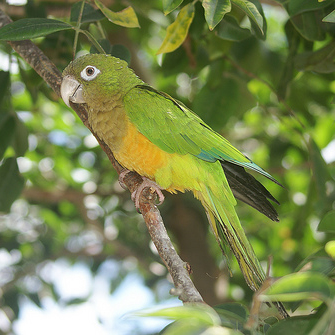 Parrots are an amazingly diverse group of birds, and today I’d like to highlight one which is given little attention by hobbyists or zoos – the unique Cactus Conure or Caatinga Parakeet (Aratinga cactorum). Unlike the rainforest denizens that usually spring to mind when mention is made of Brazil’s parrots, this enterprising bird makes it’s living in a unique cactus-studded habitat known as the Caatinga Scrub (please see photo).
Parrots are an amazingly diverse group of birds, and today I’d like to highlight one which is given little attention by hobbyists or zoos – the unique Cactus Conure or Caatinga Parakeet (Aratinga cactorum). Unlike the rainforest denizens that usually spring to mind when mention is made of Brazil’s parrots, this enterprising bird makes it’s living in a unique cactus-studded habitat known as the Caatinga Scrub (please see photo).
Description
Cactus Conures average 10-11 inches in length, and sport green plumage above and a rusty-orange breast. The head, face and throat areas are brown, shading gradually to olive. Two subspecies have been described, neither of which has been well-studied.
Range and Natural History
The Cactus Conure is limited in distribution to Northeastern Brazil, where the majority of its range is contained within Bahia State. It is adapted to a dry habitat (the Caatinga Scrub) that is dominated by cactus, succulents, thorn scrub, low trees and sturdy grasses; “semi-desert” has been used to describe some portions of this region. Cactus Conures sometimes venture into pastures and farms, where they may be hunted as crop pests.
Field studies of this bird are scarce, which is puzzling since it is so unique among South America’s Psittacines. The few published natural history accounts that are available indicate that it feeds upon cactus fruits and flowers, seeds, sprouts and buds. Small groups of 8-20 individuals have been observed, but little is known of its social behavior.
Conservation Status
The Cactus Conure’s status in the wild is also something of a mystery, and reports vary widely as regards population estimates. For now, it is listed on Appendix II of CITES and considered Near Threatened by the IUCN; detailed studies are needed. Because it is adapted to a very specific environment, and occupies a limited range, habitat loss would likely impact the Cactus Conure severely.
Captive Care
 Cactus Conures are rarely kept in either private or public collections. They are reportedly slow to accept human companionship, but once acclimated become as trusting (and remain as loud!) as most of their relatives.
Cactus Conures are rarely kept in either private or public collections. They are reportedly slow to accept human companionship, but once acclimated become as trusting (and remain as loud!) as most of their relatives.
Suggested diets contain more fruit, buds and vegetables than is typically recommended for other conures. Captive breeding is not common but occurs regularly among established pairs. The 4-6 eggs hatch in 25-30 days and the chicks fledge at age 7-8 weeks.
Parrot oddities abound – from seashore dwellers to those that nest under rocks, surprises are everywhere. I’ll cover others from time to time, and would be happy to hear about your favorites.
Further Reading
Video of wild Cactus Conures.
Cactus Parakeet images referenced from wikipedia and originally posted by Phillipe and Snowmanradio
Caatinga images referenced from wikipedia and originally posted by Allan Patrick
 That Bird Blog – Bird Care and History for Pet Birds
That Bird Blog – Bird Care and History for Pet Birds



